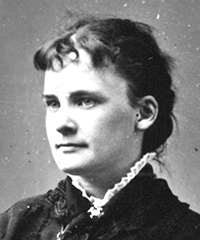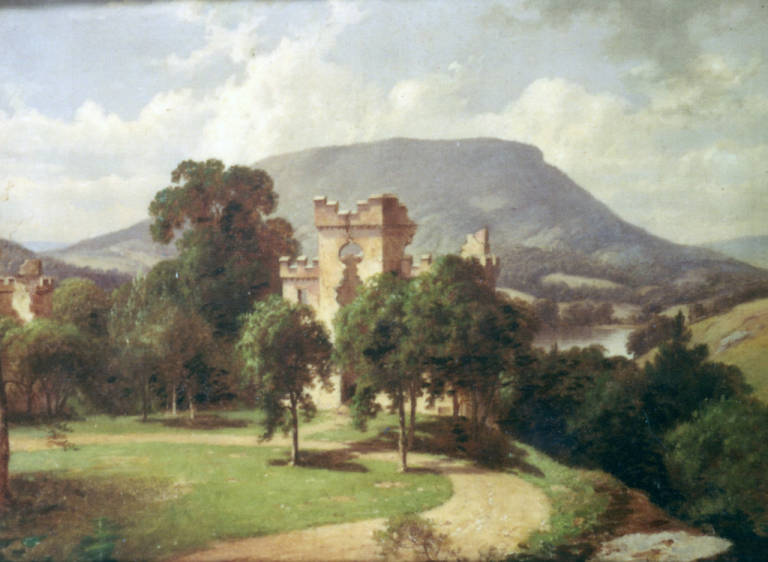
Stories you might hear in the corridors of a library . . . or at a cocktail party . . . Perhaps too brief to be a formal article . . . or too undocumented to be called “scholarly”. . . But each one too good not to be told and retold . . . “Rockbridge Anecdotes” is an offshoot of “Rockbridge Epilogues,” the more scholarly series which is endorsed by the county’s two historical organizations, Historic Lexington Foundation and the Rockbridge Historical Society. Bob Keefe is the gatekeeper of “Anecdotes” and can be reached here. |
The Nannie Jordan Chronicles
1. Nannie Jordan* (1856-1942), godmother of this series, wrote in her memoir “Smiles and Tears” about some of the social customs she experienced while growing up in 19th-century Rockbridge. 2. Nannie Jordan, raconteur with few equals, tells tales
that pleased her and us too.
3. Nannie Jordan talks about some of her favorite
people, and a few others as well.
4. Nannie Jordan takes us to interesting (and occasionally obscure) places
in Rockbridge County.
5. Nannie Jordan, who was a teacher by profession, talks about local schools. The Rest of the Anecdotes (Newest First)
30. R. E. Lee and his chief of artillery (and later his pastor), William N. Pendelton, had dinner in 1864 but they forgot to say grace first. They wrote to each other with elaborate apologies and explanations. 29. Before railroads arrived in Rockbridge, packet boats were an important way to bring people and goods from Richmond and Lynchburg. 28. Each year, the Lexington college students commemorate the attacks of 9/11. 27. In 1938, J. R. Senseney recalled a boyhood growing up in Lexington the the 1870s, filled with values and lessons, minor as well as major. 26. After the Civil War, a gifted young landscape and portrait artist named William D. Washington established the fine arts curriculum at VMI. 25. The earliest days of what became Rockbridge County were vividly recalled in an 1806 deposition by Mary McDowell Greenlee — who was 95 and sharp-witted at the time. 24. There’s a third discussion club in Rockbridge, not quite as lofty in its ambitions as the Fortnightly or Ignorance. 23. The valuable silver goods collected by George Washington, later owned by the Lees, were sent to be safely hidden at VMI during the Civil War. 22. Lexington had more than its share of forceful female personalities. Here are the stories of some of them. 21. The c. 1840 ecclesiastical war between Lexington Presbyterians and their once-beloved Scottish pastor. 20. A tour of brand-new downtown Buena Vista, in 1891, guided by a gifted storyteller. 19. The “Poet Laureate of the South,” Margaret Junkin Preston, wrote heroic poems to mark a Washington and Lee University centennial and the dedication of Stonewall Jackson's statue. Here are those epic poems. 18. John Grigsby was the patriarch of the family that built the so-called Seven Hills of Rockbridge — handsome early 19th-century brick mansions. All seven flourish today. 17. A VMI professor was Virginia’s first fisheries czar, and he invented the fish ladder. The remains of his hatchery are on North Main Street. 16. The story of Springfield, in southern Rockbridge, told by one who grew up there.
15. Cornelia McDonald was
a peripatetic Civil War wife and widow who spent a decade in Lexington —
years marked by hardship and making do with help provided by friends.
14. Lexington’s old train station was
in the way of progress, but instead of tearing it down, it was rolled across
the street and given a new life.
13. In 1934, the
oddest-looking building on the Washington and Lee campus mysteriously
burned down, and no one was sorry.
12. The Washington & Lee Swing is the most famous football marching song in the world. Here’s its story,
told by its composer.
11. Why are W&L
students called minks? Because VMI cadets said so.
10. Arthur Silver sold clothes in Lexington for much of the 20th
century, but it’s the old vaudevillian’s yarns for which he’s best remembered.
9. Education is paramount at Washington and Lee, but only after you
find a maximally convenient place to park.
8. The Old Blue Hotel was demolished soon after the Jordan House, and the two events fueled the rise and success of Lexington's preservationist movement. 7. The Jordan House (of which Nannie was
the last occupant) was torn down in 1940, but not before two determined
sisters took on the Washington and Lee board of trustees.
6. In 1974, Lexington gave its
heart to Mel Greenberg, even though he came to
town to swindle people, not win them over.
|


